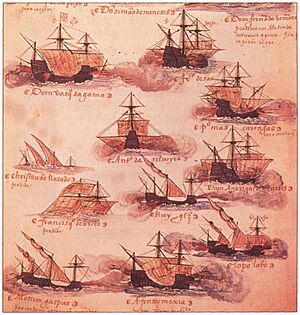Battle of Chaul facts for kids
Quick facts for kids Battle of Chaul (1508) |
|||||||
|---|---|---|---|---|---|---|---|
| Part of Mamluk–Portuguese conflicts and Gujarati–Portuguese conflicts | |||||||
 Portuguese ships, 16th century |
|||||||
|
|||||||
| Belligerents | |||||||
| Portuguese Empire | Mamluk Sultanate Gujarat Sultanate |
||||||
| Commanders and leaders | |||||||
| Lourenço de Almeida † | Amir Husain Al-Kurdi Malik Ayyaz Mayimama Marakkar † |
||||||
| Strength | |||||||
| 3 ships and 5 caravels | 6 Egyptian carracks and 6 great galleys, 1500 combatants 40 Gujarat Sultanate galleys |
||||||
| Casualties and losses | |||||||
| 6 ships 140 men |
600-700 | ||||||
The Battle of Chaul was a big naval fight that happened in 1508. It was fought between the Portuguese and a fleet from the Egyptian Mamluk kingdom. The battle took place in the harbor of Chaul in India. The Mamluk forces, helped by local Indian rulers, won this battle. It was the first time the Portuguese lost a sea battle in the Indian Ocean.
Contents
Why the Battle Happened
Trade and Control
Before this battle, the Portuguese were mostly active around Calicut in India. But the northern region of Gujarat was even more important for trade. It was a key place for goods moving between the East and West. Traders from Gujarat brought spices from the Moluccas (Spice Islands) and silk from China. They then sold these goods to Egyptian and Arab merchants.
The Portuguese wanted to control this trade. They started to block other ships and take over trade routes. This upset many people, especially the Arab traders and the city of Venice in Europe. Venice was worried because the Portuguese could now sell spices in Europe for less money. This hurt Venice's own spice trade.
Seeking Help Against Portugal
Venice decided to act. They broke off diplomatic talks with Portugal. Then, they sent an ambassador to the Egyptian Mamluk ruler. Venice asked Egypt to lower its trade taxes. This would make it easier for them to compete with the Portuguese. Venice also suggested that Egypt should take "quick and secret actions" against the Portuguese.
The ruler of Calicut, known as the Zamorin, also asked for help. He sent his own ambassador to Egypt. He wanted help against the Portuguese, who were causing trouble in his lands.
Building a Fleet
The Mamluks did not have a strong navy. So, they needed to build ships. They got wood from the Black Sea region. However, about half of this wood was stopped by the Knights of St. John near Rhodes. This meant the Mamluks could only build a small part of the fleet they planned.
The wood that did get through was carried overland by camels. It was then put together at Suez (a city in Egypt). Venetian shipwrights (people who build ships) helped them build the fleet.
Getting Ready for Battle
The Mamluk Fleet Arrives
The Mamluk fleet finally set sail in February 1507. Their leader was Amir Husain Al-Kurdi. Their goal was to stop the Portuguese from expanding in the Indian Ocean. After some delays, they reached the Indian port of Diu in 1508.
The Mamluk fleet had six large ships called carracks and six big galleys (long, oar-powered ships). About 1,500 fighters were on board. The ambassador from the Zamorin of Calicut, Mayimama Mārakkār, was also with them.
Joining Forces
The Mamluk fleet planned to meet up with Malik Ayyaz. He was a former slave who now worked for the Sultan Mahmud Begada of the Gujarat Sultanate. Malik Ayyaz was the naval chief and leader of Diu.
The plan was for the Mamluks, Malik Ayyaz, and the Zamorin of Calicut to join forces. Together, they would attack and destroy all Portuguese bases on the Indian coast. However, the Zamorin had expected the Mamluk fleet in 1507 and had already left.
The Battle of Chaul
The Portuguese forces were led by Lourenço de Almeida. He was the son of the Portuguese Viceroy, Francisco de Almeida. The Portuguese had fewer ships and a lighter force. They were located in the nearby harbor of Chaul. The rest of their ships had sailed north to protect other trade routes.
The Mamluks sailed into Chaul harbor. They fought the Portuguese for two days. The fighting was fierce, but neither side could win clearly. The Mamluks tried to board the Portuguese ships but couldn't.
Finally, Malik Ayyaz arrived with his own galleys. With more ships joining the Mamluk side, the Portuguese had to retreat. Lourenço de Almeida's ship was sunk at the entrance of Chaul harbor, and he died in the battle. After the battle, Amir Hussain returned to Diu. However, his ships became old and his crews left. He did not try to attack the Portuguese again on the Indian coast.
What Happened Next
A Costly Victory
Even though the Muslim forces won, it was a very costly victory for them. This is sometimes called a Pyrrhic victory, meaning the cost of winning was almost as bad as losing. Hussain lost between 600 and 700 of his 800 soldiers. The remaining soldiers were now afraid of the European weapons.
Portuguese Revenge
The Portuguese did not give up. They came back later and attacked the Mamluk fleet in the harbor of Diu. This led to a very important Portuguese victory in the Battle of Diu (1509).
Years later, the Ottoman Empire also tried to intervene in the region. This led to the Siege of Diu (1538) in 1538.
More to Explore
- Battle of Cannanore
- Portuguese India

